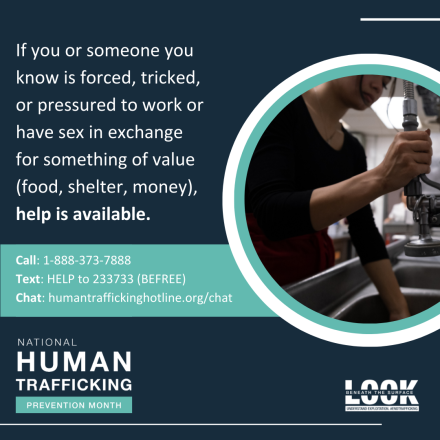Who Are the Traffickers?
Reality: Human trafficking is the use of force, fraud or coercion to get another person to provide labor or commercial sex. Worldwide, experts believe there are more situations of labor trafficking than of sex trafficking. However, there is much wider awareness of sex trafficking in the United States than of labor trafficking.
Reality: One study estimates that as many as half of sex trafficking victims and survivors are male. Advocates believe that percentage may be even higher but that male victims are far less likely to be identified. LGBTQ boys and young men are seen as particularly vulnerable to trafficking.
Reality: Human trafficking is often confused with human smuggling, which involves illegal border crossings. In fact, the crime of human trafficking does not require any movement whatsoever. Survivors can be recruited and trafficked in their own home towns, even their own homes.
Reality: Many survivors have been trafficked by romantic partners, including spouses, and by family members, including parents.
Reality: That is sometimes the case. More often, however, people in trafficking situations stay for reasons that are more complicated. Some lack the basic necessities to physically get out - such as transportation or a safe place to live. Some are afraid for their safety. Some have been so effectively manipulated that they do not identify at that point as being under the control of another person.
- Factsheet: T & U Visa and Continued Presence
- Hotline: National Human Trafficking Hotline
- Video: How to Apply for a Certification Letter for Foreign National Adults Who Experience Human Trafficking
- Video: How to Apply for an Eligibility Letter for Foreign National Minors Who Experienced Human Trafficking
Forced Labor:
- Factsheet: CBP Forced Labor Webpage
- Factsheet: Forced Labor and the Clean Energy Transition: Finding a Responsible Way Forward
- Factsheet: Forced Labor in China's Xinjiang Region
- Factsheet: Forced Labor: The Hidden Cost of China’s Belt and Road Initiative
- Factsheet: How does CBP enforce 19 U.S.C. 1307?
- Factsheet: Uyghur Forced Labor Prevention Act Factsheet
- Factsheet: What can importers do to help combat forced labor?
- Factsheet: Due Diligence in Global Supply Chains
- Information Memorandum: Federal Statutory and Regulatory Framework on Forced Labor in Healthcare and Public Health Supply Chains
- Report: Department of Labor’s 2021 Findings on the Worst Forms of Child Labor
- Report: Department of Labor’s 2022 List of Goods Produced by Child Labor or Forced Labor
- Resource: CBP Withhold Release Orders and Findings
- Resource: Forced Labor Frequently Asked Questions
- Resource: Sample Blog Post on Labor Trafficking from DOJ OVC [see page 2]
- Resource: Uyghur Forced Labor Prevention Act
Survivor-related:
- Factsheet: Unifying Trauma-Informed Practices and Voices of Survivor Leadership
- Report: HTLA Class 1 Recommendations on Survivor Informed Practices
- Resource: Empowering Survivors: Four Ways USAID is countering human trafficking
- Resource: Survivor Voices of Human Trafficking
- Toolkit: Building Survivor-Informed Organizations
- Toolkit: Survivor-Informed Practice Self-Guided Assessment



